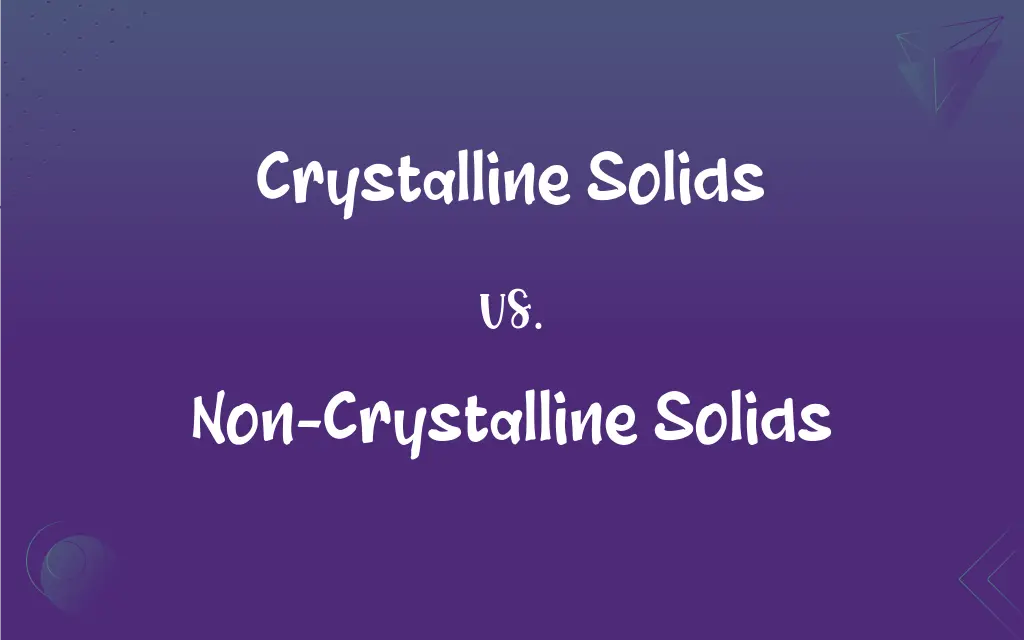Crystalline Solids vs. Non-Crystalline Solids: What's the Difference?
By Janet White & Harlon Moss || Published on March 6, 2024
Crystalline solids feature a long-range ordered structure, while non-crystalline solids lack such regularity, displaying an amorphous or disordered arrangement.

Key Differences
Crystalline solids are characterized by a highly ordered structure, with atoms, ions, or molecules arranged in a repetitive, three-dimensional lattice that extends throughout the material. This order gives rise to distinct geometric shapes and sharp melting points. Non-crystalline solids, also known as amorphous solids, lack this long-range order, displaying a more random arrangement of their constituent particles, which leads to the absence of clear geometric shapes and a range of melting temperatures.
The ordered structure of crystalline solids results in unique and predictable physical properties, such as clear cleavage planes, anisotropy in electrical and thermal conductivity, and distinct melting points. In contrast, non-crystalline solids exhibit more uniform properties in all directions (isotropy) and do not have sharp melting points; instead, they soften over a temperature range. This fundamental difference in internal structure affects not only the physical properties but also the applications of these materials.
Crystalline solids are often utilized in applications where their unique structural and physical properties are advantageous, such as semiconductors, minerals, and metals. Non-crystalline solids find their use in different applications where uniform properties are desired or where the material is required to be easily molded or shaped, such as in glasses, polymers, and various amorphous materials used in industry.
Understanding the distinction between crystalline and non-crystalline solids is crucial in material science, impacting the synthesis, processing, and application of materials in fields ranging from electronics to pharmaceuticals. The choice between crystalline and non-crystalline forms can significantly affect the performance, durability, and suitability of materials for specific applications, underscoring the importance of this fundamental classification in solid-state chemistry.
Comparison Chart
Structural Order
Long-range order with a repetitive lattice.
Lack of long-range order; atoms or molecules are arranged randomly.
ADVERTISEMENT
Melting Point
Sharp melting points.
Do not have sharp melting points; soften over a range of temperatures.
Physical Properties
Anisotropic; properties depend on direction.
Isotropic; properties are uniform in all directions.
Shape
Often form geometric shapes with flat faces.
Lack geometric shape; form irregular or rounded shapes.
Examples
Quartz, table salt, metals.
Glass, plastics, gels.
Crystalline Solids and Non-Crystalline Solids Definitions
Crystalline Solids
Natural planes of separation within a crystal.
Mica sheets easily separate along cleavage planes due to their crystalline structure.
ADVERTISEMENT
Non-Crystalline Solids
A liquid cooled below its freezing point without crystallizing.
Silica glass is often considered a supercooled liquid due to its non-crystalline structure.
Crystalline Solids
A repetitive, ordered arrangement of atoms.
In a crystal of table salt, sodium, and chloride ions form a cubic lattice.
Non-Crystalline Solids
The change in size with temperature.
Non-crystalline solids like glass have a uniform thermal expansion, unlike crystalline solids, which may expand differently along different crystal axes.
Crystalline Solids
Variation in physical properties with direction.
The electrical conductivity of a crystalline solid like graphite varies depending on the direction of measurement.
Non-Crystalline Solids
The temperature range where an amorphous solid becomes soft.
Glass transitions into a more fluid state over a range of temperatures, not at a specific melting point.
Crystalline Solids
The external shape reflecting the internal order.
Crystals of snowflakes exhibit hexagonal geometric shapes due to their internal lattice.
Non-Crystalline Solids
Uniform properties in all directions.
Amorphous polymers exhibit isotropic mechanical properties, making them ideal for various applications.
Crystalline Solids
The smallest repeating unit in a crystal lattice.
The diamond cubic structure has a specific unit cell that repeats throughout the crystal.
Non-Crystalline Solids
A structure without a long-range order.
The atoms in glass are arranged randomly, lacking a crystalline lattice.
FAQs
How are crystalline and non-crystalline solids formed?
Crystalline solids form through processes that allow atoms to arrange in a repetitive pattern, such as slow cooling from a melt. Non-crystalline solids often form from rapid cooling, which prevents atoms from arranging into a crystalline structure.
Can a material be both crystalline and non-crystalline?
Yes, some materials can have both crystalline and non-crystalline regions, known as semi-crystalline materials, often found in polymers.
What applications rely on the unique properties of non-crystalline solids?
Applications like optical fibers, certain types of coatings, and amorphous metals in transformers rely on the uniform and isotropic properties of non-crystalline solids.
What role does temperature play in the formation of non-crystalline solids?
Temperature plays a crucial role; rapid cooling or quenching from a melt can prevent the orderly arrangement of atoms, leading to the formation of non-crystalline (amorphous) structures.
Can crystalline solids be made into non-crystalline solids?
Yes, crystalline solids can be converted into non-crystalline solids through processes like melting and rapid cooling, which disrupt the ordered lattice structure.
Can the crystalline state of a solid be identified visually?
In some cases, the crystalline state can be suggested by visual inspection, such as the presence of faceted shapes indicating a crystalline structure, but definitive identification often requires analytical techniques like X-ray diffraction.
How does the structure of a crystalline solid affect its properties?
The ordered structure of a crystalline solid leads to directional properties (anisotropy), affecting its mechanical, electrical, and thermal behavior.
How does light transmission differ between crystalline and non-crystalline solids?
Light transmission can vary significantly; crystalline solids may exhibit birefringence due to their anisotropic structure, while non-crystalline solids like glass typically allow uniform light transmission due to their isotropy.
How does the electrical conductivity of crystalline solids compare to non-crystalline solids?
Crystalline solids often exhibit directional electrical conductivity (anisotropic), while non-crystalline solids generally show uniform conductivity in all directions (isotropic), though the actual conductivity levels can vary widely based on the specific material.
Why do non-crystalline solids lack a sharp melting point?
Non-crystalline solids lack a sharp melting point because their disordered structure does not undergo a distinct, single-phase transition like crystalline solids.
What is the significance of defects in crystalline solids?
Defects in crystalline solids, such as vacancies or interstitials, can significantly affect their properties, including electrical conductivity, mechanical strength, and diffusion rates, often playing a crucial role in semiconductor technology.
How do pharmaceuticals exploit the differences between crystalline and non-crystalline solids?
Pharmaceuticals often utilize crystalline forms for their predictable solubility and stability, while non-crystalline (amorphous) forms can be used to enhance solubility and bioavailability of drugs with poor solubility in crystalline form.
How does the thermal conductivity of crystalline solids compare to non-crystalline solids?
Crystalline solids often have higher and anisotropic thermal conductivity due to their ordered lattice, allowing efficient heat transfer along certain directions, whereas non-crystalline solids generally exhibit lower and isotropic thermal conductivity.
Can crystallinity affect the color of a solid?
Crystallinity can influence the color of a solid; for example, the interaction of light with the ordered structure of a crystalline solid can lead to selective absorption or scattering, affecting its appearance, while non-crystalline solids may show more uniform coloration.
What impact do crystalline and non-crystalline structures have on solubility?
Solubility can be affected by the structure; crystalline solids might show solubility that depends on the crystal face exposed to the solvent, while non-crystalline solids generally have more uniform solubility characteristics.
What advancements have been made in transitioning materials between crystalline and non-crystalline states?
Advances in materials science have led to sophisticated techniques for controlling the crystalline state of materials, including controlled cooling, pressure application, and chemical doping, allowing the production of materials with tailored properties for specific applications.
What challenges do non-crystalline solids pose in materials science?
The lack of long-range order in non-crystalline solids can complicate the prediction and control of their properties, presenting challenges in designing materials with specific characteristics.
How do crystalline and non-crystalline solids respond to mechanical stress?
Crystalline solids may show anisotropic mechanical properties, with strength varying along different crystal axes, while non-crystalline solids typically exhibit isotropic mechanical behavior, with uniform strength and elasticity in all directions.
What are the environmental stability differences between crystalline and non-crystalline solids?
Crystalline solids may be more stable under environmental conditions that align with their ordered structure, while non-crystalline solids can be more resistant to conditions that disrupt crystalline order, such as radiation or high pressure.
What are the implications of crystalline and non-crystalline structures in nanotechnology?
In nanotechnology, the distinction between crystalline and non-crystalline structures is crucial for designing nanoparticles and nanostructures with desired optical, electronic, and mechanical properties, influencing applications from electronics to drug delivery.
About Author
Written by
Janet WhiteJanet White has been an esteemed writer and blogger for Difference Wiki. Holding a Master's degree in Science and Medical Journalism from the prestigious Boston University, she has consistently demonstrated her expertise and passion for her field. When she's not immersed in her work, Janet relishes her time exercising, delving into a good book, and cherishing moments with friends and family.
Co-written by
Harlon MossHarlon is a seasoned quality moderator and accomplished content writer for Difference Wiki. An alumnus of the prestigious University of California, he earned his degree in Computer Science. Leveraging his academic background, Harlon brings a meticulous and informed perspective to his work, ensuring content accuracy and excellence.































































